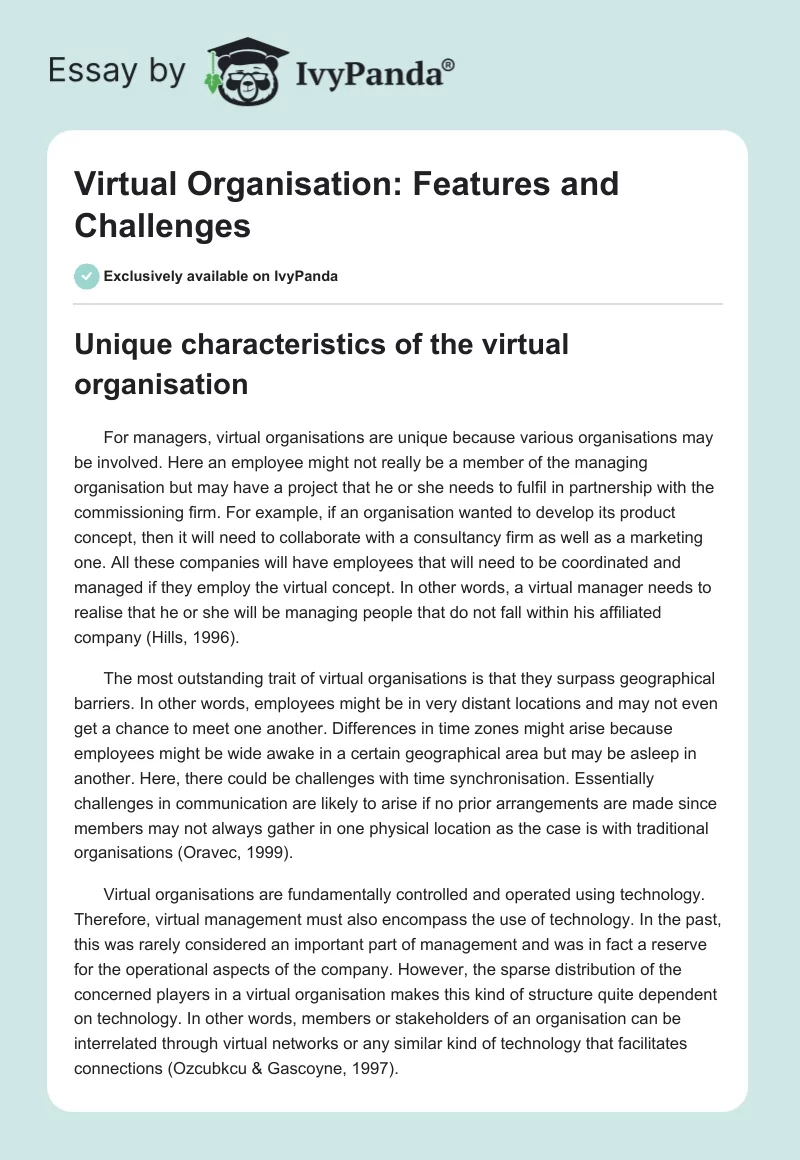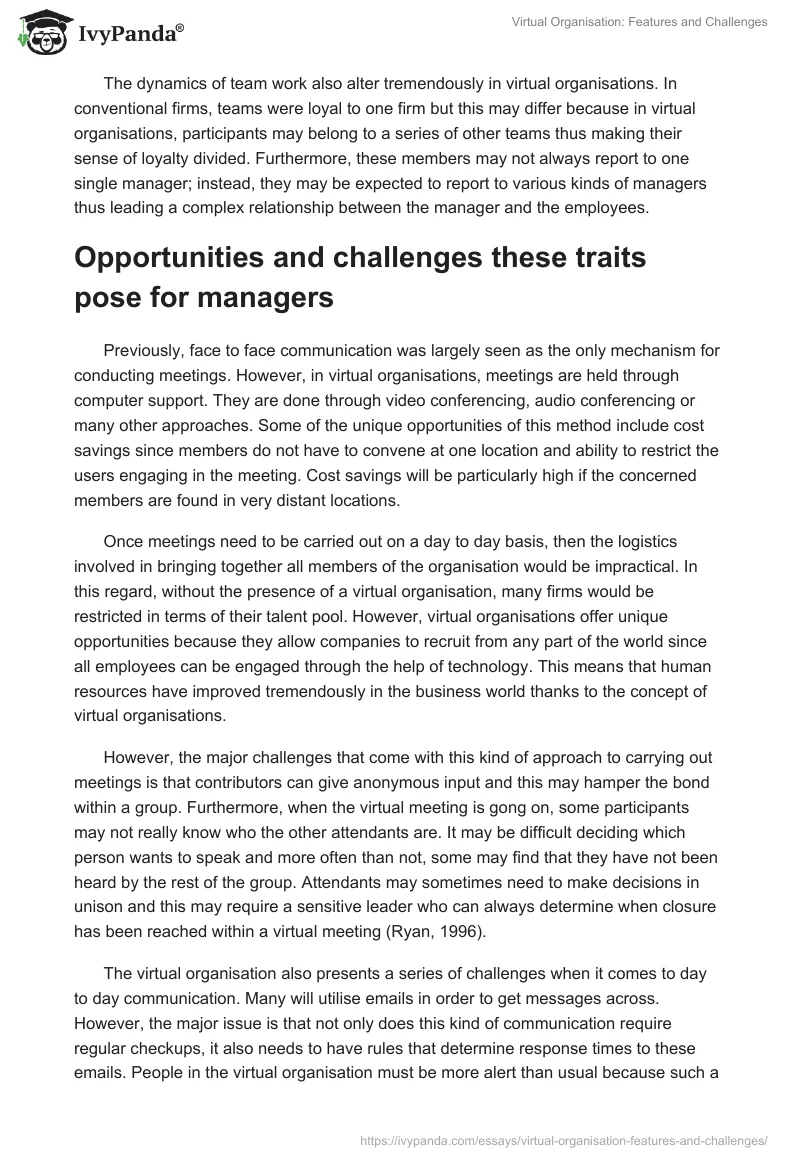Unique characteristics of the virtual organisation
For managers, virtual organisations are unique because various organisations may be involved. Here an employee might not really be a member of the managing organisation but may have a project that he or she needs to fulfil in partnership with the commissioning firm. For example, if an organisation wanted to develop its product concept, then it will need to collaborate with a consultancy firm as well as a marketing one. All these companies will have employees that will need to be coordinated and managed if they employ the virtual concept. In other words, a virtual manager needs to realise that he or she will be managing people that do not fall within his affiliated company (Hills, 1996).
The most outstanding trait of virtual organisations is that they surpass geographical barriers. In other words, employees might be in very distant locations and may not even get a chance to meet one another. Differences in time zones might arise because employees might be wide awake in a certain geographical area but may be asleep in another. Here, there could be challenges with time synchronisation. Essentially challenges in communication are likely to arise if no prior arrangements are made since members may not always gather in one physical location as the case is with traditional organisations (Oravec, 1999).
Virtual organisations are fundamentally controlled and operated using technology. Therefore, virtual management must also encompass the use of technology. In the past, this was rarely considered an important part of management and was in fact a reserve for the operational aspects of the company. However, the sparse distribution of the concerned players in a virtual organisation makes this kind of structure quite dependent on technology. In other words, members or stakeholders of an organisation can be interrelated through virtual networks or any similar kind of technology that facilitates connections (Ozcubkcu & Gascoyne, 1997).
The dynamics of team work also alter tremendously in virtual organisations. In conventional firms, teams were loyal to one firm but this may differ because in virtual organisations, participants may belong to a series of other teams thus making their sense of loyalty divided. Furthermore, these members may not always report to one single manager; instead, they may be expected to report to various kinds of managers thus leading a complex relationship between the manager and the employees.
Opportunities and challenges these traits pose for managers
Previously, face to face communication was largely seen as the only mechanism for conducting meetings. However, in virtual organisations, meetings are held through computer support. They are done through video conferencing, audio conferencing or many other approaches. Some of the unique opportunities of this method include cost savings since members do not have to convene at one location and ability to restrict the users engaging in the meeting. Cost savings will be particularly high if the concerned members are found in very distant locations.
Once meetings need to be carried out on a day to day basis, then the logistics involved in bringing together all members of the organisation would be impractical. In this regard, without the presence of a virtual organisation, many firms would be restricted in terms of their talent pool. However, virtual organisations offer unique opportunities because they allow companies to recruit from any part of the world since all employees can be engaged through the help of technology. This means that human resources have improved tremendously in the business world thanks to the concept of virtual organisations.
However, the major challenges that come with this kind of approach to carrying out meetings is that contributors can give anonymous input and this may hamper the bond within a group. Furthermore, when the virtual meeting is gong on, some participants may not really know who the other attendants are. It may be difficult deciding which person wants to speak and more often than not, some may find that they have not been heard by the rest of the group. Attendants may sometimes need to make decisions in unison and this may require a sensitive leader who can always determine when closure has been reached within a virtual meeting (Ryan, 1996).
The virtual organisation also presents a series of challenges when it comes to day to day communication. Many will utilise emails in order to get messages across. However, the major issue is that not only does this kind of communication require regular checkups, it also needs to have rules that determine response times to these emails. People in the virtual organisation must be more alert than usual because such a form of communication is what really keeps them going. However, the tone used in the emails and the style embraced by managers needs to be carefully chosen because certain styles like the very authoritative ones may make particular members of the virtual organisation to feel isolated (Harrasim & Turoff, 1995).
Another unique challenge associated with the management of virtual organisations is the problem of conflict amongst members of the organisation. It is likely that conflicts can be difficult to detect when all the people concerned participate in organisational work at different times. Organisational processes would be easily harboured once there is no way of harmonising workplace relationships. These are normally more complex because not everyone can be found at the same time or within the same location. Trust may also be lacking in the virtual environment if a manager does not make the deliberate effort to inculcate it amongst his members.
The problem of trust and conflicts that arise out of lacking a particular focal point amongst members of the virtual organisation can be solved by forging a clear purpose that team members need to have. In this regard, members of the virtual firm will all have a clear purpose which they are working towards. They will stay committed to this purpose and once managers keep reminding them about it then chances are that it may continue to build a sense of loyalty amongst the employees towards the virtual organisation. Several technologically based communications can be used in order to remind workers about the tasks, timings and goals of such organisations (Vaill, 1996).
The virtual organisation is different from conventional firms because not only is technology central to the operation of such a firm but it also plays a crucial role in managing them. One challenge that can stem from technology is that users may not be well conversant with a new form of technology or software. Therefore, it is quite easy for the concerned members to misunderstand one another or to get frustrated by new technologies. Managers can easily solve this problem by providing them with specialists who can then teach them the expertise needed in order to deal with different kinds of media. Additionally, plenty of technical support will be essential so that all involved members can easily understand their challenges (Senge, 1990).
Virtual organisations have to challenge popular notions of technology. Traditional firms thought of technology as a means of data storage and although this aspect may still be exist in virtual companies, there are still other important uses of technology. One such use is to facilitate daily conversations with concerned participants. Technology as a communication and relationship building tool is essential in the virtual organisation although certain new members may not be aware of this.
It is the role of the virtual manager to let his employees or partners know that technology will have more applications than the usual ones. At the end of it, it will be essential for this manager to look for ways in which he or she can promote and facilitate communication between members of the organisation. Failure to do so could cause employees to try and transfer popular notions of technology from traditional organisations to virtual organisations and this could only lead to inefficiency or even failure (Kostner, 1997).
Coordination and communication of employees in these types of organisations is of the essence. Members who base their communication behaviour on assumptions are bound to cause complications in performing tasks. When employees are not aware of the frequency of communication, the response times they should consider or the style that they should adopt when communicating to their superiors then this could seriously harbour their work. Managers can easily solve this problem by laying some ground rules on giving feedback, carrying out and initiating communication. Members of the virtual organisation should be immensely involved in setting up these ground rules so that they can be willing to implement it (Khan, 1997).
Interactions with fellow virtual team members may be a problem in this kind of business model. Concerned individuals need to know when they can log onto the virtual organisation and try to get things done. The major challenge with them is that if one member of the team logs on too frequently; i.e. five times daily, while others log on once a day then this pace would be too fast for the latter group than the former. In the end, some members of the organisation will be left behind.
A high number of virtual employees often consider the latest information over and above anything else that has been added before. Consequently, only those who log in at the most frequent times will be at a position of staying up to date. All the others will simply have too much information that has gone past them before they can even respond to it. Managers have the unique position of determining which pace would be ideal for the company as when logging in occurs too frequently or too rarely, the organisation is bound to suffer through delineation of some workers (Hirotaka & Nonaka, 1995).
In line with the previous statement is the issue of employees who had been part of another organisation but now have to join up with some of the individuals in the new one. Alternatively, some employees in virtual organisations may have separated from a certain project team and may have to re-enter the group at a later date when a lot of activity has already gone on. This could make the new entrants feel out of place. Managers can deal with this challenge by creating ways of welcoming and integrating new team members.
Geographical differences can be both a problem and an opportunity. They are an opportunity because they allow virtual organisations to tap into the global talent pool; however, they are a challenge because they require utmost consideration of differences in work cultures, work practices and even time zone. The virtual manager needs to overcome these inadequacies by carefully analysing the people he works with and by understanding how he can weave them together so that they can achieve organisational objectives.
References
Hirotaka, T. & Nonaka, I. (1995). The knowledge creating firm. Oxford: OUP.
Harrasim, L. & Turoff, M. (1995). Learning networks. MA: MIT press.
Vaill, P. (1996). Learning as a way of being. NJ: Jossey Bass.
Kostner, J. (1997).Virtual leadership. NY: Warner books.
Ryan, B. (1996). The corporate intranet. NY: Wiley.
Ozcubkcu, K. & Gascoyne, R. (1997). Corporate internet planning. Berlin: Van Nostrand.
Khan, B. (1997). Web based instruction. Chicago: Educational technology publishers.
Hills, M. (1996). Intranet as groupware. NY: Wiley.
Oravec, J. (1999). Human dimension of computer networking. Cambridge: CUP.
Senge, P. (1990). The art and practice of the learning organisation. Doubleday.


